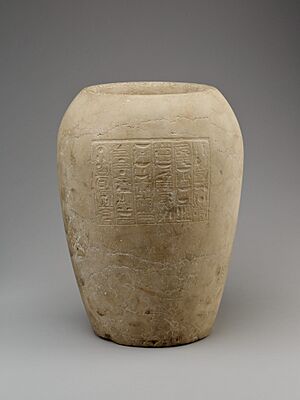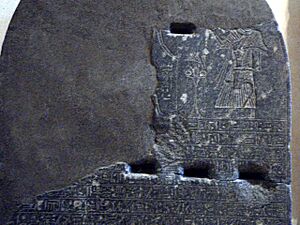Smendes facts for kids
Quick facts for kids Smendes |
|
|---|---|
| Nesbanebdjed, Nesibanebdjedet | |

Canopic jar of Smendes, Metropolitan Museum of Art.
|
|
| Pharaoh | |
| Reign | c. 1077/1076–1052 BC (21st Dynasty) |
| Predecessor | Ramesses XI |
| Successor | Amenemnisu |
| Consort | Tentamun B |
| Children | Amenemnisu ? |
| Mother | probably Hrere |
| Died | 1052 BC |
| Burial | Unknown |
Smendes was an important ruler in Ancient Egypt. He founded the Twenty-first Dynasty of Egypt, a new line of pharaohs. Smendes became king after the death of Ramesses XI, taking control of Lower Egypt. His Egyptian birth name was Nesbanebdjed, which means "He of the Ram, Lord of Mendes". Later, Greek writers called him Smendes.
Smendes was a governor in Lower Egypt during the time of Ramesses XI. This period was known as the "Era of the Renaissance," a time of renewal for Egypt. However, experts are still debating how accurate some of the stories from this time are.
Smendes' Family Life
Smendes might have been the son of a woman named Hrere. She was an important priestess in the temple of Amun-Re. If Hrere was his mother, then Smendes was also the brother of Nodjmet. This would make him related to the powerful High Priests Herihor and Piankh.
Smendes was married to a woman named Tentamun B. She was likely a daughter of an earlier pharaoh, Ramesses IX. Smendes and Tentamun B may have been the parents of Amenemnisu, who became king after Smendes.
The Story of Wenamun
Smendes plays a big part in an ancient Egyptian story called the Report of Wenamun. This story is set in "Year 5" of a time called the Renaissance. This was during the rule of Ramesses XI, the last king of the Twentieth Dynasty.
In the story, a priest named Wenamun is sent on a mission. He travels from Karnak to the city of Byblos in Phoenicia. His goal is to get cedar wood to build a new boat for the god Amun.
Wenamun first visits Smendes in the city of Tanis. He shows Smendes his official letters. Smendes then gives Wenamun permission to travel north. He also provides a ship for Wenamun's journey to Syria and the Levant. This shows that Smendes was a very important person in Tanis at that time.
Smendes' Time as Pharaoh
Smendes ruled Egypt for about 26 years. We know this from ancient records. One important stone tablet, called the Banishment Stela, mentions his 25th year as king. This tablet tells us that a High Priest named Menkheperre stopped a rebellion in the city of Thebes. The leaders of this rebellion were sent away to the Western Desert. They were later allowed to return when Smendes' successor, Amenemnisu, became king.
Smendes' power was mainly in Lower Egypt. The southern parts of Egypt, known as Middle and Upper Egypt, were mostly controlled by powerful High Priests of Amun. These priests included Pinedjem I, Masaharta, and Menkheperre.
Smendes' royal name, Hedjkheperre Setepenre, was very popular. It means 'Bright is the Manifestation of Rê, Chosen of Rê/Amun'. Many later kings used this name for themselves. After Smendes died in 1052 BC, his son Amenemnisu likely took over as pharaoh.
We have not yet found Smendes' tomb. The only item from his burial is a Canopic jar. This jar once held his liver and is now in the Metropolitan Museum of Art. This might mean his tomb was robbed a long time ago, but we don't know for sure.


